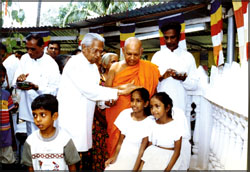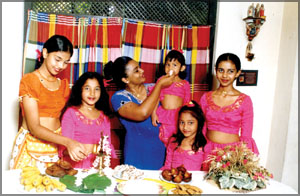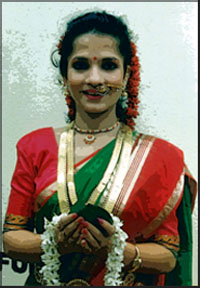Sinhala and Hindu New Year Celebrations
by Sumana Saparamadu
The sweet melody of the
koha and the fragrance of erabadu mal signal that it's time to usher in
a new year, once again. As the entire nation prepares to celebrate the
Sinhala and Hindu New Year on April 14, we will examine some of the
age-old tradition
and rituals observed
during this time, and also find out what auspicious times are all
about...
Auspicious times
Sighting of the New
Moon
The auspicious time to see the new moon for the coming solar year
will be on Thursday, April 19.
Bathing for the old
year
This should be done on Thursday, April 12.
Dawn of the New Year
The New Year dawns at 12.21 p.m. on Saturday, April 14.
Punya Kalaya (time for
religious activities
The period between 6.05 a.m. on Saturday,April 14 and 6.53 on
Saturday, April 14 is deemed to be the Punya Kalaya or Nonagathaya. It
is advised to give up all work before 6.05 a.m. on the 14th and engage
in religious activities such as visiting the temple.
Lighting the hearth
and cooking the first meal
The custom at lighting the hearth falls at the auspicious time of
1.01 p.m. on Saturday, April 14.Lighting the hearth should be done
wearing blue clothes and facing the south.
Commencement of work, first
transaction and consumption of the first meal
The first meal should be consumed at 2.51 p.m. on Saturday, April 14,
wearing blue clothes and facing the South after commencing work and
other transactions.
Anointing oil
It is advisable to anoint the nanu on the head at 8.21 a.m. on
Sunday, April 15 while standing on Nuga leaves with Imbul leaves hanging
over one's head, wearing reddish/yellow clothes.
Leaving home for work
The auspicious time to leave home for work falls at 6.11 a.m. on
Thursday, April 19.
***
Anointing the head
The rites of the Sinhala New Year festival end with the anointing of
the head and the first bath for the New Year. This may be two or three
days after New Year's day or the gap may be longer, but never more than
a week. A special oil is prepared at the temple.
week. A special oil is prepared at the temple.
The astrologer specifies the time and the direction one should face
when anointing the head.
Sometimes there is mass anointing at the temple, with the monk
anointing the heads of males.
This anointing should be done with the person being anointed standing
on the leaves of a specified tree and holding the leaves of another tree
above the head.
The leaves to be used are determined by the day on which the
anointing is done. Just as there is a special colour for each day of the
week, there is also a special tree (see box).
The leaves of the tree special to the day's presiding plant should be
held above the head, while standing on the leaves that were held
overhead last year. But, if that day was Thursday last year, there is an
exception this year. Thursday's tree is the Bo tree. It is a sacrilege
to trample Bo leaves. So there will be no leaves underfoot.
The day of the anointing and first bath is different among the
Tamils. I quote Prof. Bertram Bastianpillai....
"Early in the morning on New Year's Day Hindus clad in new clothes
wend their way to the kovil before any other activity is undertaken. The
devotee collects what is termed in Tamil as 'Maruthu Neer or
medicinal water.
"This therapeutic liquid is prepared out of a mixture of medicinal
herbs with three kinds of flowers, the lotus, the pomegranate and the
fragrant flower of the screw pine.
"Those who have brought home the 'Maruthu Neer' will take the
bath for the New Year applying some medicinal water on their heads. It
is an act of purification and one starts off the New Year in that pure
state." - (Daily News, April 13 ,1995).
***
Traditional sweetmeats
The milk-rice cooked at the auspicious time specified by the
astrologer will be the centre-piece of the table laid out for the first meal of the New Year. In Sinhala homes, the milk-rice
is cooked in coconut milk, but in Tamil homes, the milk-rice is
sweetened with jaggery and enriched by adding raisins and cadjunuts.
out for the first meal of the New Year. In Sinhala homes, the milk-rice
is cooked in coconut milk, but in Tamil homes, the milk-rice is
sweetened with jaggery and enriched by adding raisins and cadjunuts.
There will also be kevum (oil-cakes) in Sinhala homes and a comb of
plantains preferably kolikuttu. The rich yellow of the ripe plantains
adds colour to the table.
Other traditional fare include kokis, aasmi, kaludodol, aluva, and
veli talapa. Different districts have their special sweetmeats like the
peni wallalu in Matale and the naarang kevum in Badulla.
These are little balls the size of naarang, made of coconut boiled in
treacle (peni pol), mixed with flour, flavoured with cinnamon and
cardomoms, then dipped in batter and deep fried.
The Avurudu table will not be complete without a lamp at one end or
at the centre of the table, which will be lit by the head of the
household before the family sits down to the meal. In most parts of the
island, no fish, meat or eggs are included in the Avurudu breakfast. The
first meal is entirely vegetarian.
Now cakes and marshmallows have found their way to the Avurudu Mesay
(table) in urban homes.
In very few town houses are sweetmeats made by the mother or the
teenage daughters.
Almost all items can be bought in the supermarkets or there are women
young and old, who have specialised in the making of certain items viz
kevum or aasmi or bibikkan and will take on orders. These items require
a special skill in the making.
***
The sheaf of betel
The common or garden betel leaf has a very important place during
Avurudu (New Year). Avurudu will not be Avurudu without the sheaf of betel. It is a must for the observance of a
very important custom - greeting elders and paying one's respect, and
also to do 'ganu denu'.
Avurudu without the sheaf of betel. It is a must for the observance of a
very important custom - greeting elders and paying one's respect, and
also to do 'ganu denu'.
In some parts of the country, children offer betel (bulath denawa) to
their parents before sitting down to the first meal. Grown up sons and
daughters, married and living away from the parental home will not fail
to bring a sheaf or sheaves of betel when they come on their new year
visit on New Year's Day or in the next day or two.
Employees will visit their master / employer on New Year's Day or the
day after and offer a bulath atha - sheaf of betel. Until about 30/35
years ago, a rolled up tobacco leaf was placed on the sheaf of betel and
given to the master. This was called a bulath hurulla.
The tobacco leaf is not used any more. The offering of betel is not
only a form of greeting and paying one's respects. That act is also a
silent plea for pardon for any wrongs done in the past 12 months.
When two persons or two families have not been on good terms in the
past many months, the younger kinsman or colleague or subordinate will
visit the elder at New Year and offer a sheaf of betel. With the giving
and accepting of the betel, all ill-feelings will be (or should be)
erased and wrongs forgiven and forgotten.
A bulath atha is made up of 40 leaves. But today, few offer a full
sheaf. What is offered may be 20 leaves or even less. The number of
leaves is not important. It is the giving and the accepting that is
important!
***
How auspicious times are calculated
The European Calendar, or the Gregorian Calendar (so called because
it was introduced by Pope Gregory XIII), is the international calendar now followed worldwide.
is the international calendar now followed worldwide.
But, different races, ethnic groups and adherents (supporters) of
some religions, have their own calendar and celebrate the beginning of a
new year at various times. The Chinese New Year begins sometime in
February of the European/Gregorian Calendar.
The Iranians reckon the beginning of the new year from the vernal
equinox (March 21) and the beginning of the Jewish new year coincides
with the autumnal equinox (Sept. 23). The Muslim year is a lunar year,
so New Year's Day varies.
The Sinhala and Hindu New Year begins, as you all know, in mid- April
of the European calendar, about three weeks after the vernal equinox.
All South and South East Asia, from Sri Lanka and Tamil Nadu, India to
Laos, will be celebrating the dawn of a new year this Saturday.
Ours is a solar year. When the Sun has made 'a full round of the
zodiac one year has ended.' Zodiac as explained in the Oxford
Dictionary is "an imaginary area of the sky containing the positions of
the Sun, Moon and the main planets, and divided into 12 equal parts
named after 12 groups of signs."
These parts are referred to as 'raasi' in astrology. The time the Sun
takes to pass through all 12 'raasi', beginning with Aries
(Mesha) and ending with Pisces (Meena), marks one year.The old year
doesn't end and a new year begin at the stroke of midnight on the last
day of the last month of the year, as in the European or Gregorian
Calendar.
The time when the Sun leaves Pisces (Meena raasi) and enters Aries (Mesha
raasi) to begin another cycle or round of the zodiac, varies from year
to year. Astrologers calculate the exact hour and minute when this
happens. This transition from Pisces to Aries, is known as 'Sankranti'.
There is a short gap or internal between the time the Sun leaves
Pisces (Meena) and enters Aries (Mesha). This gap in time is known as
'Punya Kaala' (Sinhala)and punya Kaalam (Tamil) -
which means time for meritorious acts. It is also called 'Nonagatha'
- a time of 'no action'.
All work must cease before the nonagatha, food cooked,
the fire put out and the hearth cleaned. No activity should be started
and no food consumed until the New Year has dawned. Since this is the 'Punya
Kala', families will visit the local vihara or kovil to spend the time
in prayer and devotion.
There are auspicious times for each activity in the new year, like
lighting the fire, having the first meal, making money transactions etc.
In times past, the King's astrologer handed the 'neketh vattoruwa',
the list of auspicious times, to the king, and the king's men spread the
information. In areas far from the capital, each village or group of
villages had their own astrologer to inform the people the auspicious
times for the various rites of the New Year festival.
Now the newspapers, television and radio give this information
regarding auspicious times, auspicious colours and the direction to face
when lighting the hearth etc. (See box). The media gives this
information after consulting astrologers.
***
Auspicious colours
The auspicious colour is determined by the day on which the New Year
begins. Each day has a presiding planet and each planet has its special
colour. New Year's Day this year falls on Saturday. The colour for this
year is blue. These are the colours special to the planets and therefore
to each day. Sun and Moon are regarded as planets in astrology.
Day colour Tree
Sunday copper Imbul
Monday pearl(white) Woodapple (divul)
Tuesday red -
Wednesday green neem (kohomba)
Thursday gold Bo
Friday multi colour karanda
Saturday black and blue banyan (nuga)
Courtesy: Subasetha
You may have been curious as to why one colour is considered
auspicious one year and another colour in another year. Now you know
why.
Let me digress (move away from the topic) a little, to tell you
something interesting. Some of you may have heard of the great Indian
singer, Lata Mangeskar. She always wears white sarees with a coloured
border. It is said that she chooses a saree with a border in the colour
special for that day. If it is a Sunday, when she has to give a public
recital, she'll wear a saree with a gold border.
In choosing gifts for family members too, some people buy a saree /
frock / shirt of the lucky colour for the new year. |
